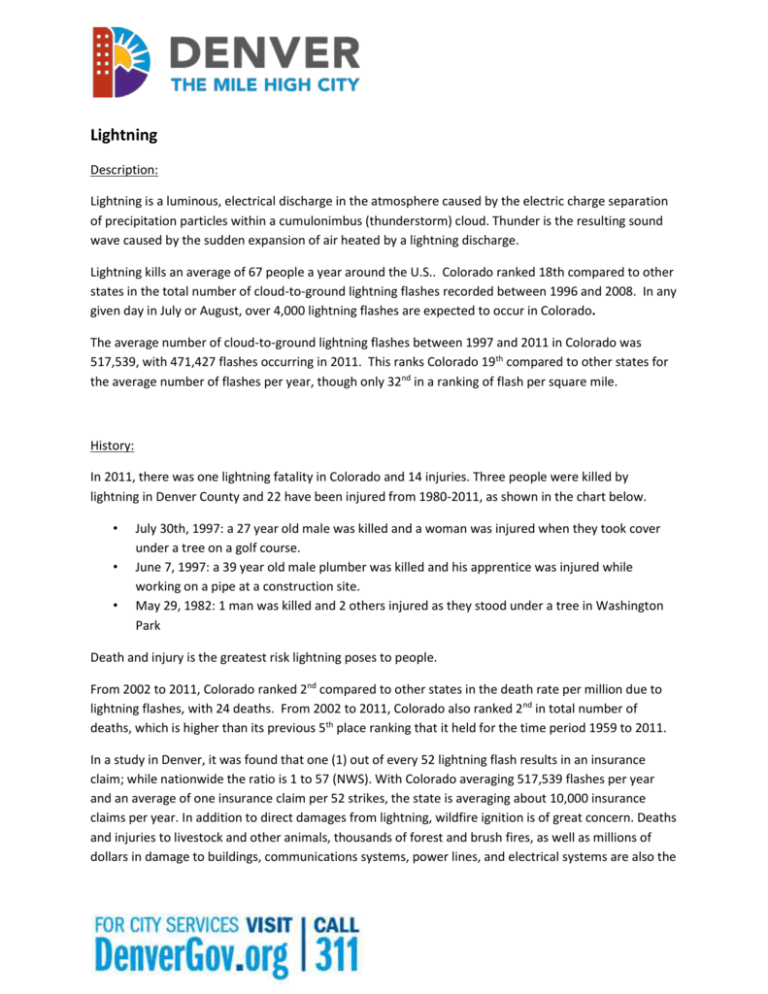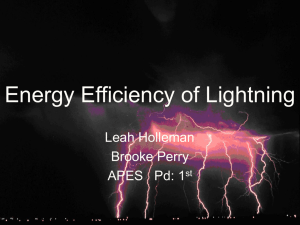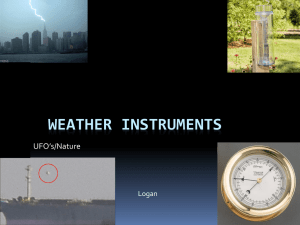Lightning - City and County of Denver
advertisement

Lightning Description: Lightning is a luminous, electrical discharge in the atmosphere caused by the electric charge separation of precipitation particles within a cumulonimbus (thunderstorm) cloud. Thunder is the resulting sound wave caused by the sudden expansion of air heated by a lightning discharge. Lightning kills an average of 67 people a year around the U.S.. Colorado ranked 18th compared to other states in the total number of cloud-to-ground lightning flashes recorded between 1996 and 2008. In any given day in July or August, over 4,000 lightning flashes are expected to occur in Colorado. The average number of cloud-to-ground lightning flashes between 1997 and 2011 in Colorado was 517,539, with 471,427 flashes occurring in 2011. This ranks Colorado 19th compared to other states for the average number of flashes per year, though only 32nd in a ranking of flash per square mile. History: In 2011, there was one lightning fatality in Colorado and 14 injuries. Three people were killed by lightning in Denver County and 22 have been injured from 1980-2011, as shown in the chart below. • • • July 30th, 1997: a 27 year old male was killed and a woman was injured when they took cover under a tree on a golf course. June 7, 1997: a 39 year old male plumber was killed and his apprentice was injured while working on a pipe at a construction site. May 29, 1982: 1 man was killed and 2 others injured as they stood under a tree in Washington Park Death and injury is the greatest risk lightning poses to people. From 2002 to 2011, Colorado ranked 2nd compared to other states in the death rate per million due to lightning flashes, with 24 deaths. From 2002 to 2011, Colorado also ranked 2nd in total number of deaths, which is higher than its previous 5th place ranking that it held for the time period 1959 to 2011. In a study in Denver, it was found that one (1) out of every 52 lightning flash results in an insurance claim; while nationwide the ratio is 1 to 57 (NWS). With Colorado averaging 517,539 flashes per year and an average of one insurance claim per 52 strikes, the state is averaging about 10,000 insurance claims per year. In addition to direct damages from lightning, wildfire ignition is of great concern. Deaths and injuries to livestock and other animals, thousands of forest and brush fires, as well as millions of dollars in damage to buildings, communications systems, power lines, and electrical systems are also the result of lightning. Total property damage reported from lightning strikes in Colorado is $19.4 million over the last 50 years. Preparedness: Familiarize yourself with the terms that are used to identify a thunderstorm hazard, including understanding the difference between a severe thunderstorm watch and a severe thunderstorm warning. • Thunderstorm Watch: there is a possibility of a thunderstorm in your area. • Thunderstorm Warning: a thunderstorm is occurring or will likely occur soon. Take shelter immediately. Remove dead or rotting trees and branches that could fall and cause injury or damage during a severe thunderstorm. Use the 30/30 lightning safety rule. If you see lightning and you cannot count to 30 before hearing thunder, go indoors. Then stay indoors for 30 minutes after hearing the last clap of thunder. Listen to weather-alert radios to stay informed of thunderstorm watches and warnings. Check out Ready.gov/thunderstorms-lightning for more information about what to do before, during, and after severe thunderstorms. Learn more: NOAA – Lightning Safety: When Thunder Roars, Go Indoors! Sources: Colorado Division of Emergency Management (CDEM) Spatial Hazard Events and Losses Database for the United States (SHELDUS) National Weather Service (NWS) National Observation and Atmospheric Association (NOAA)







